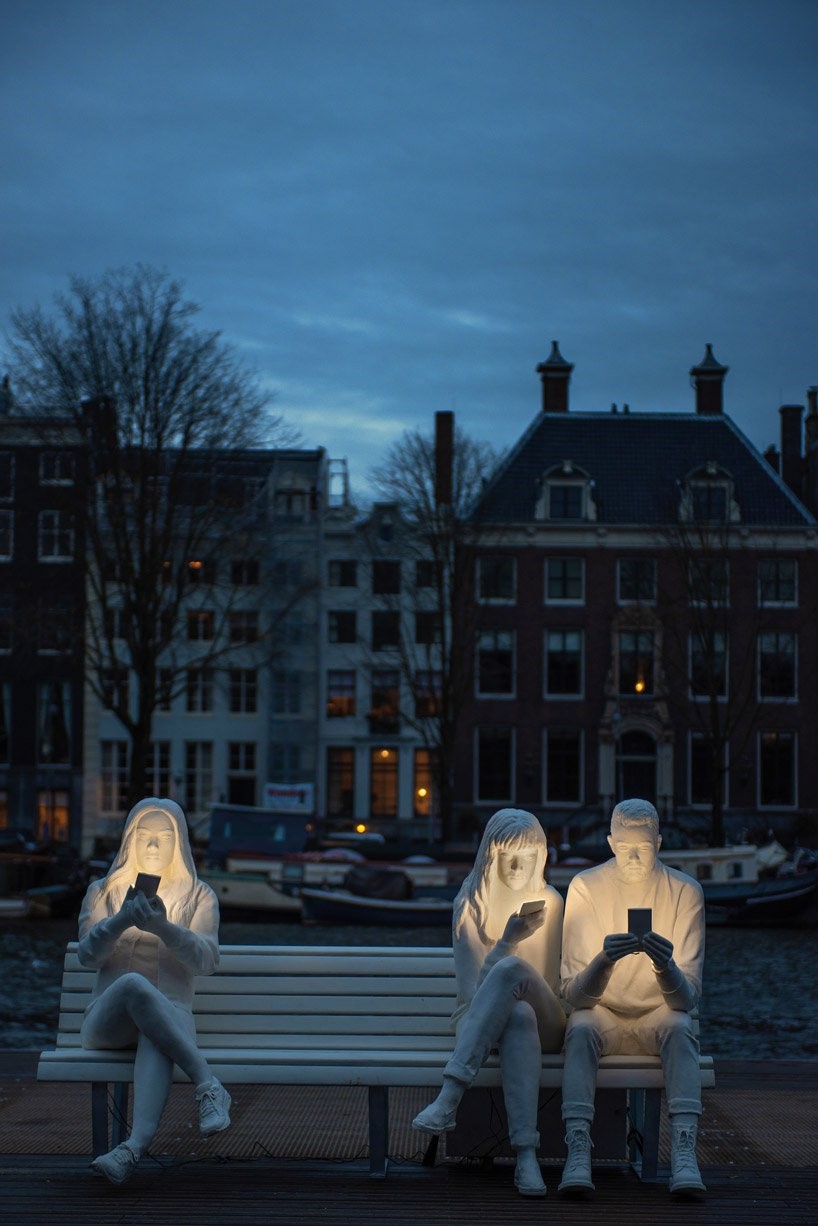The medium is the message
The Amsterdam Light Festival 2018-2019
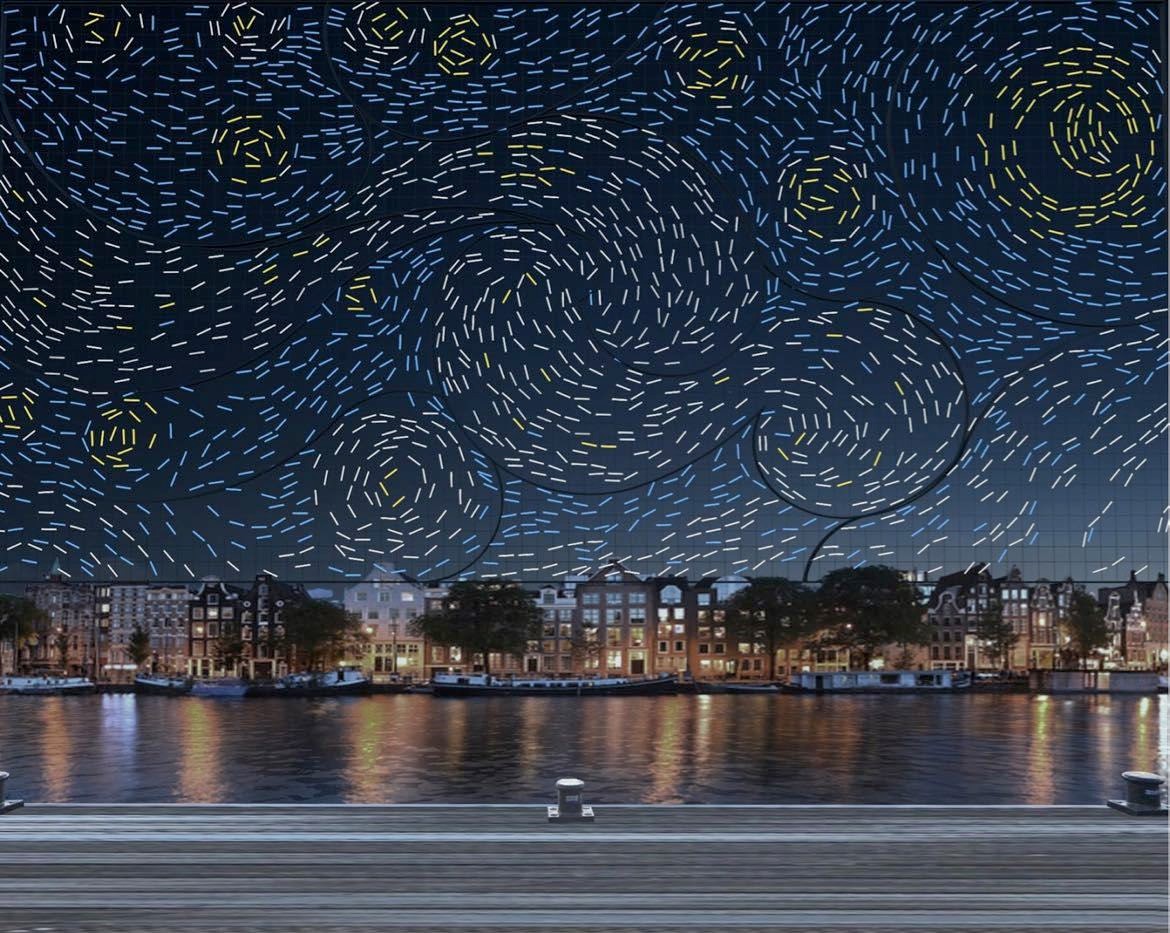
On the canal bank opposite to The American Hotel in Amsterdam stands a huge, ancient tree. It was recently revealed that trees communicate with each other. They form interconnected networks. Trees relay underground messages to each other by using a media, such as fungi in the soil: a mushroom messaging system. Certain more individually-minded trees opt out of the network: the loners who stay out of the loop.
The night is drab with a light drizzly rain. The lights of passing traffic reflect in wet tarmac.
Under the tree a grey-haired older man is looking intently up into the crown of the tree. The knuckle of his right hand pressed against his upper lip only adds to the sense that he is looking for something or maybe intently at something: a treasure perhaps, a jewel of wisdom up there in tree branches heavy with old-age. Some of the thick lower branches have had to be cradled by a webbing harness so that the upper branches above can carry some of their great weight. Perhaps some nocturnal creature up in the branches of the tree has captivated the man?
No!
What has captivated him is an exquisitely carved wooden figure that now so blends into the tree that it appears to have been up there for many growth rings of passing seasons.
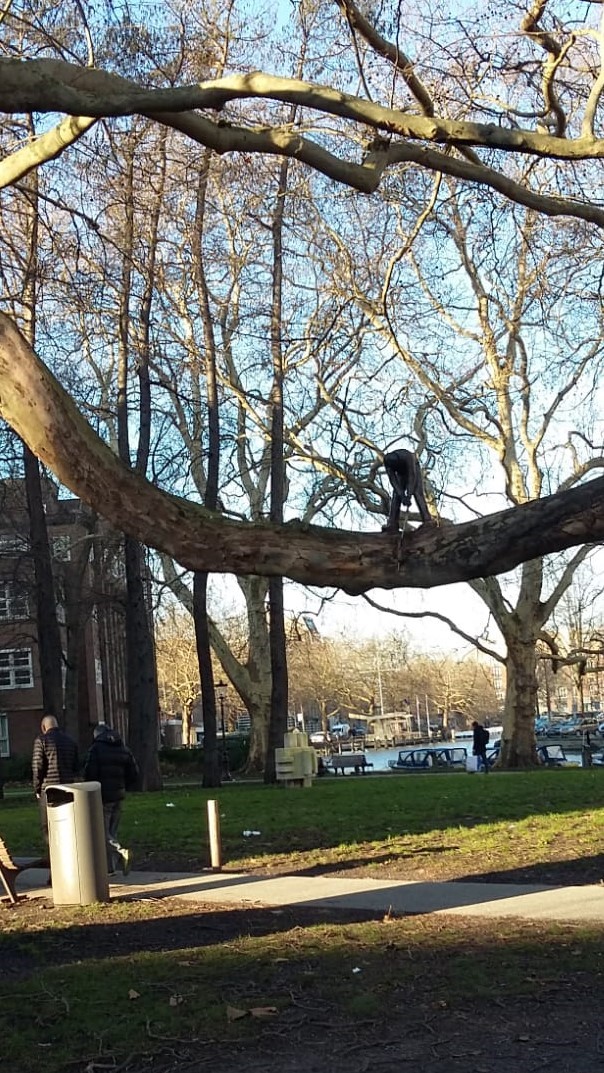
Nothing around guides the attention of a casual passerby to the wooden figure’s presence. To see the sculpture one would have to be looking intently in order to spot the discrete little statue of a Woodman, a Forester. He is busily sawing his way through the branch that he stands upon! If the figure were to stretch upright in order to ease his stooping back, he would be all of 60cm tall.
Whoever carved this little figure clearly understood well the woodcraft of using a saw.
What is the figure doing up there?
Is it a joke– that he is so skillfully sawing his way through the branch that is supporting him?
Is the slightly perplexed grey-haired man looking up at him, an ageing tree-hugging hippie?
As he shakes his head ever so slightly and turns to walk away, he seems to have divined something from the tree and the troll-like little figure. In a subtle way he seems somehow different – perhaps just slightly less perplexed.
He is brought sharply out of his reverie as he steps briskly out of the way, dodging a flock of the ever-present bikes of the city of Amsterdam.
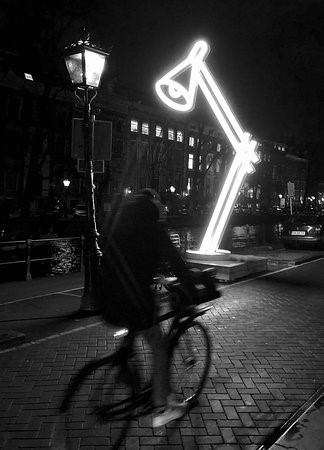
A young man, false tan, bejewelled ears, slaps his Smartphone camera onto the window of the sedately cruising canal barge. It is a murky wet night. The raindrops on the window break-up the light reflecting from the waters of the canal into broken shards. On the screen of his smartphone the image is riveting and vivid. The amazing digital technology has so enhanced and picked up the reflected light. What is on the screen is a stunningly attractive image. The raindrops create a striking effect: an image uncannily like a Van Gogh painting. The effect of the raindrops, rather than obscuring the light installations beyond the window, makes the screen-image shimmer and glow with an inner light and radiance.
My eyes and my attention are riveted to that screen. I so want to be in that scene imaged on the screen. As the fake-tanned brown hand presses a button to click and capture the image, I realise that – hey – I am in that scene! It is as if the young man’s hand holding the digital device against the window, places a digitised version on top of the reality beyond the rain-streaked window. That image will, by now, have been instantly posted onto a social-media platform like Facebook or SnapChat.
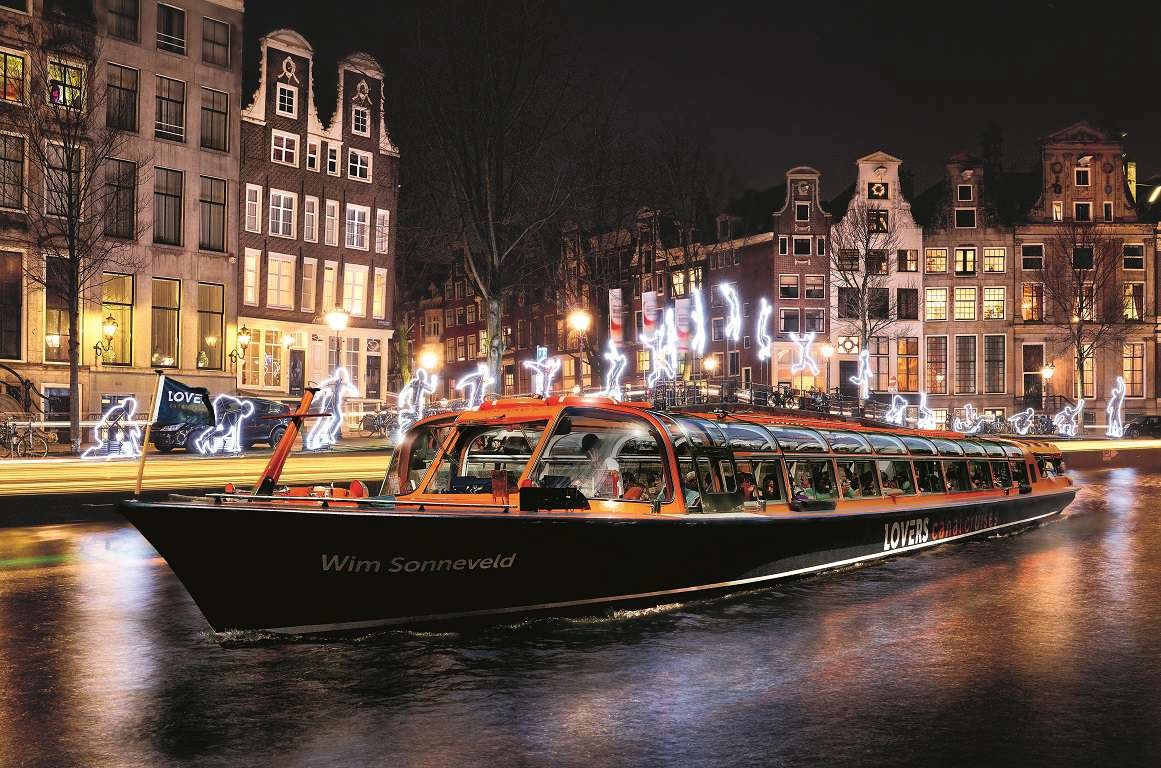
The reality that surrounds me seems somewhat drab. I sit cold and uncomfortable on a barge seat straining to look out of a bleared and mucky window, often having to strain to glance over the shoulder of other tourists visiting the Light Festival: the ones who got to the window seat first! In my dull, uncomfortable reality, my neck aches from continually screwing my head ‘round trying to piece together the partial glimpses of the light festival installations. The digitised version in the camera image slapped so assertively on the window is so much more attractive, brighter and more vivid. Again I find myself captured by the thought that I so want to be in that scene. Once more, I remind myself that I am.
I suppose to the glitzy young couples on board I cut a rather drab figure, old and – well a bit sadly impoverished: the only passenger who isn’t clutching a smart phone, camera or a tablet or a laptop to capture the event. Whatever reality is being constructed out-there in digital cyberspace, it is certainly much more attention-grabbing, vivid and exciting. I feel out of it. I begin to imagine how those images on Facebook might look if I were to ‘visit’ the social platform that the two young couples, who sit in the two seats up ahead of me, have just posted up on social media. I guess it is likely that I might once again experience a desire to be there -but I am!
When the cruise is over I will take my puzzlement over to the old tree that stands on the canal bank opposite the American Hotel in Amsterdam. I will log onto a very different net.
Will the medium convey to me a message?
Will it bewilder or will it clarify?
The medium is the message
“The medium is the message” is the theme for this year’s Amsterdam light festival (2018 -2019). The festival runs from November 2018 to the end of January 2019. A news feature on the BBC television about a British contribution to the light festival brought me here to Amsterdam to see the Light Festival.
The installation entitled “Absorbing the Light” has been created by Gali May Lucas.

It depicts three life-size figures that glow in the blue-white light of their digital devices.
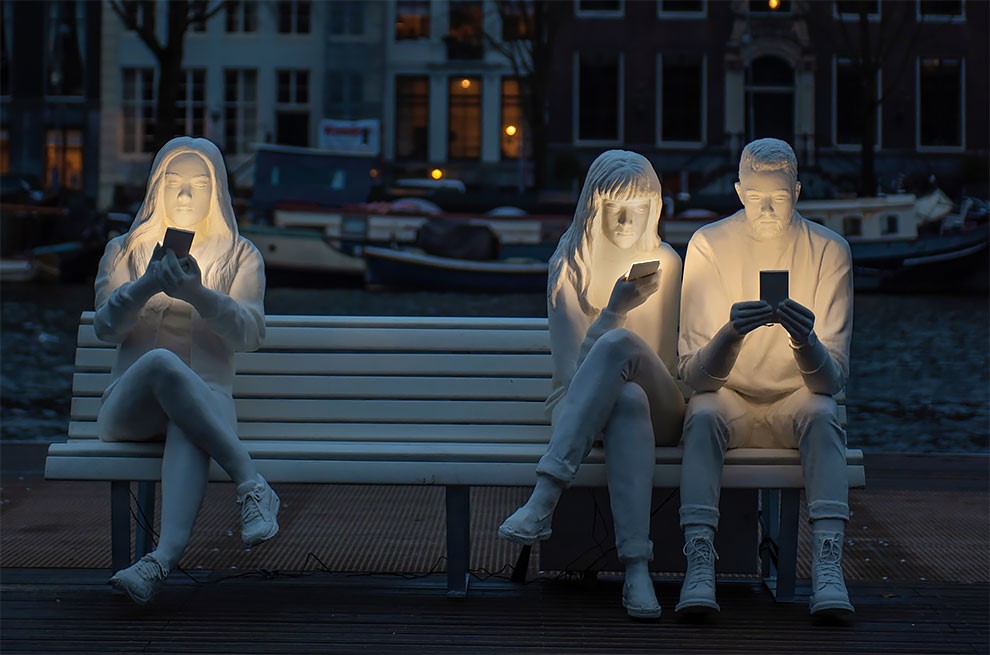
Amongst other scintillating light installations they sit on a bench by the Amstel River opposite the Heritage Museum. They are not looking around at surrounding artworks. The three white figures are engrossed and absorbed in their smartphones. It is as if the white-blue light has absorbed their entire body and being. Although they sit close together, they seem somehow insulated: the forms appear alone – isolated from what is around them. Completely entranced by the glowing blue-light of their digital devices, they seem not to be in any kind of relationship or communication with one another.
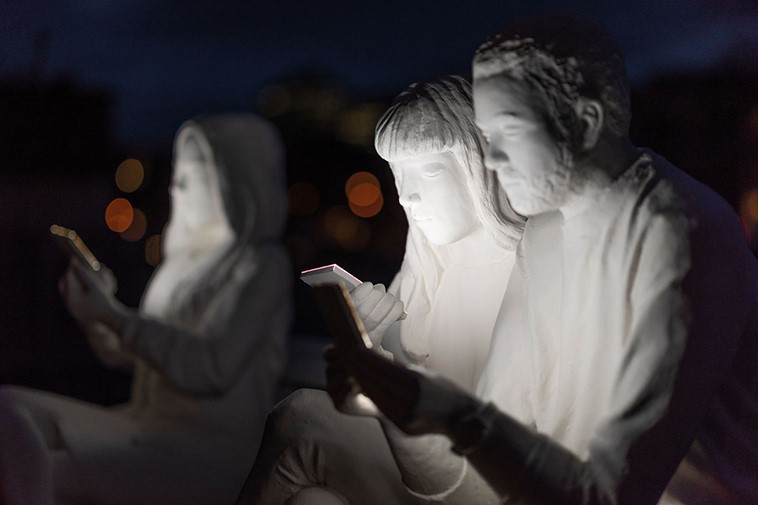
On the Light Festival Canal Cruise a recorded commentary begins with a few words about: “The medium is the message” theme of this year’s festival. It talks about how the journey will take participants through the ancient canal network of Amsterdam.

The commentary explains that the network represents a grid-like system of ancient communication and travel that in itself is a form of media. It carries a message!
The surrounding opulent warehouses and palatial houses carry tacit messages about the ancient dominance and wealth of the Dutch Empire.
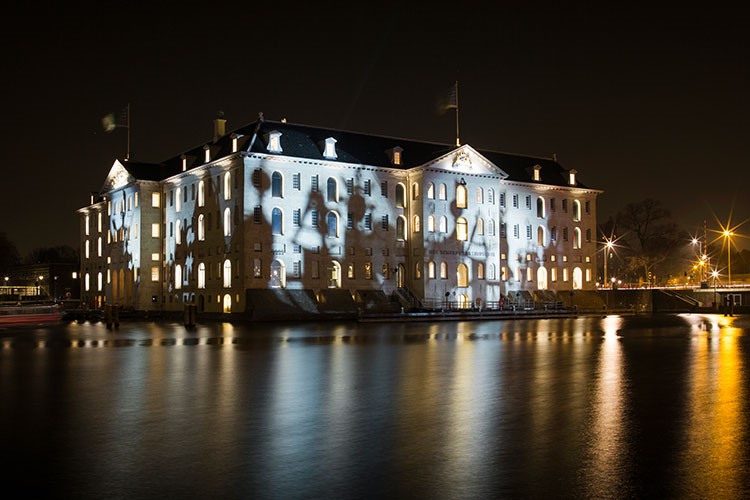
The opening commentary offers a promising start: something very different from the expected: “Welcome to Amsterdam: The Venice of the North”, the more typical and frothy, tourist babble.
The two young couples occupy the two seats in front. For the entire 90 minute cruise they will continually message and photograph each other in various poses with the Amsterdam Light Festival as a backdrop. The two young couples are expensively dressed and the young women are heavily made-up. At a certain point make-up can become quite hideous, and have the opposite effect of making a face appear more attractive. In particular false eyelashes extending beyond a certain critical length look to my eye, hideously deformed. A rather cynical thought occurs: that actually, this really doesn’t matter that much because the heavy make-up is not applied in order to be attractive to those around but for how the video and photo images will appear on social media. Certainly there is an incessant use of the smartphone not as a communication device but as a mirror used to check how the face looks– on the screen.
At one point I am relieved to see the young woman who sits behind her friend, reaching forward with her hand to lightly and seemingly quite sensuously, touch the hair of the young woman in front where her friend’s glossy blonde tresses drape over the back of the seat. What happens next completely alters my interpretation of what is happening – and just as I am thinking, here is a moment of genuine friendly touch and real human contact, a bit of primal mutual preening perhaps?
No.
She has reached her hand forward to rearrange the drapery of her friend’s hair in order to photograph it. She then promptly and instantly messages the image to her friend – so that her friend could checkout how the back of her head looks as well as the front! Could that be called virtual preening!
This little scenario on “The medium is the message” Light Show Tour neatly encapsulates the way that contemporary communication through digital social-media works: such that by far the majority of communication passes through a Third-Party Server that is operated by Attention Engineers who know all that there is to know about the extent to which, “The medium is the message”!
The smart phone arrogantly slapped against the window of reality is a powerful symbol:
“Get a load of this – yer sad bastard!”
The digital images on the screen will always draw, absorb and capture human attention and they are designed to do just that. It is a hard ask to go against millions of years of evolution that have shaped eye and brain to pick out and to select the most vivid, the fastest moving, the most flickering and brightest of sights and sounds around. The digitised images or sounds are bound to draw and capture my attention, unless that is: I discipline and train it to be otherwise. Another Big Call! My eyes will inevitably flick away from the natural, unmade-up face to the heavily made-up screen version. My eyes will do this in much the same way as they did with the smartphone image slapped on the rain-streaked window. Perhaps then, I can forgive myself for the nagging returning desire to be in that highly attractive digitally enhanced world.
The point of entry to that digital world is a device. I need a device in order to be “in-with-the-in-crowd”, to be like the others and also – for others to like me -at least enough to remain part of the group! These are highly evolved social urges that have been shaped by the stark reality that in prehistory rejection by the group spells near certain extinction for a lone human being. Again: to ask to go against such powerful survival instincts is a Big Call. However the fact remains: a world of digital social media, a human creation is actually a starkly different virtual world than the very real physical world that shaped our early evolution. I may be hugely devastated by hundreds of ‘thumbs-down dislikes’, however, I do not face actual physical extinction because of the rejection. Nonetheless it is more than likely that I will behave as if this were the case: a form of virtual extinction. Cyber-bullying is a serious and tragic issue leading to self-harming and many deaths by suicide particularly among vulnerable young people.
All around me on the tour I am surrounded by media and by bewildering messages of all varieties and kinds; people’s clothes; the light installations, the barge seat, the canal, surrounding conversations – never mind the ever-present, incessant clicking, whistling, pinging, dinging, vibrating of many digital devices.
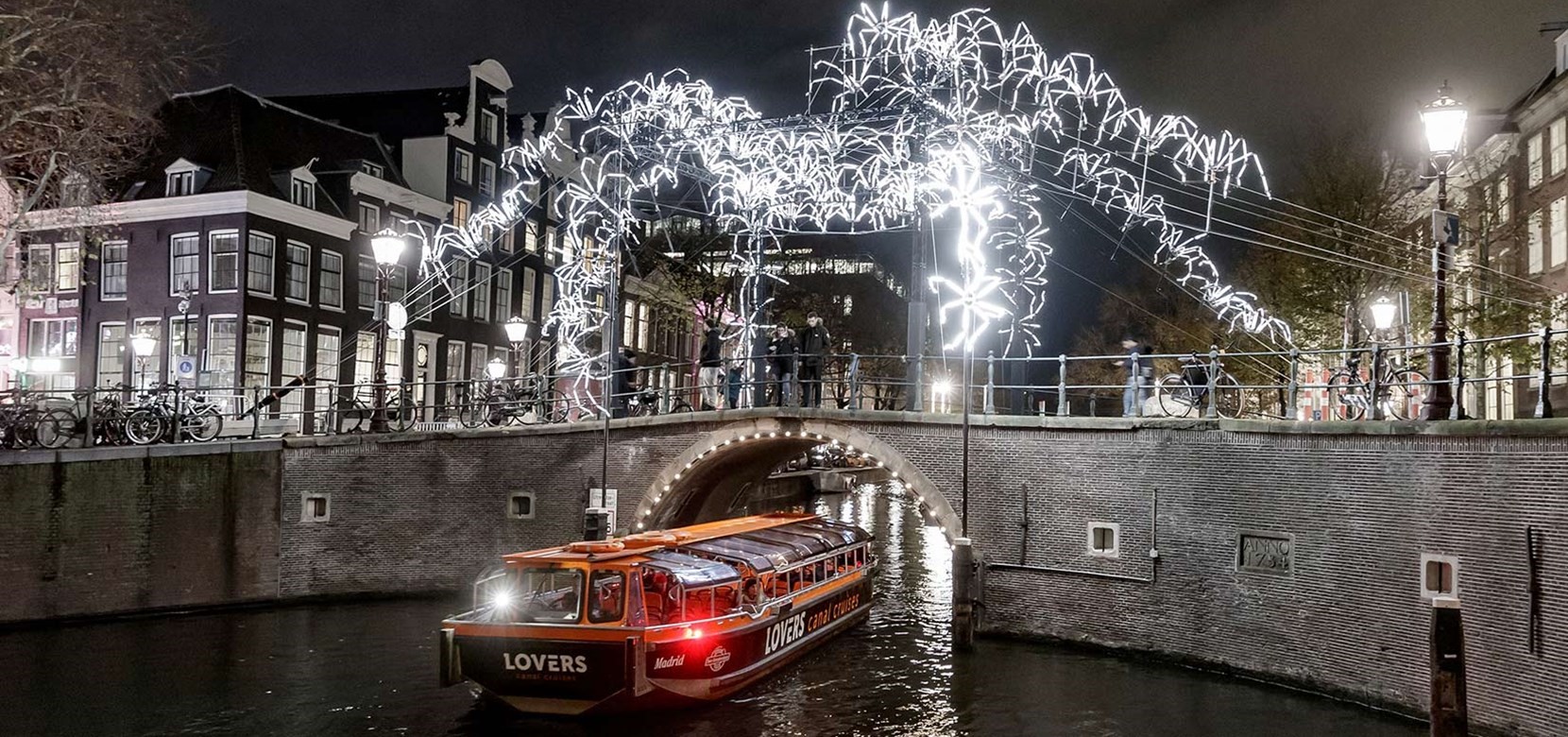
Maybe it is the boat and the lapping water that brings to mind the ancient Greek myth of Ulysses and the Odyssey. As I recall it, in the myth of the Sirens, Ulysses commands his crew to tie him securely to the mast of the boat. His men are then blindfolded and ear-muffed as they row Ulysses passed the irresistible sights and sounds of the Sirens. Entranced, Ulysses begs, pleads, commands his crew to take him to the Sirens but his men cannot hear his orders or see the irresistible Sirens – and so he is saved from a terrible fate. The extraordinary lure of attention engineering seems similarly almost as irresistible!
Hand-held devices draw us into is a digital world of proliferating neediness. The first need: to buy and own a digital device that will be constantly glued to the owner. This is the port of entry into the alternative digital universe. It would make sense here to turn the noun ”device” into a related verb “to device”. It would then be accurate to say that the young people and most others aboard the tourist barge, spent most of the trip of devicing. That is: charging, holding, messaging, photographing, videoing, servicing the constant attention-grabbing dings, alarms, whistles, clicks, notifications, the e-mail checking and the incessant screen tapping and flicking.
Most of the activities of devicing pass through the overseeing Eye of a third-party Server. The server is constantly present in what amounts to a really quite eerie way. There is no distance between the Devicer and the Server. To “visit” a social platform you need never take a single step to leave the spot, never make any journey in real-time. In this way real time starts to disappear. Everything now becomes instant: communication – now, gratification – now; buying now. Nothing needs to develop along a real-world timeline. This shrinks the present moment to the point of extinction, as an awareness of what is going on around you in the real-world diminishes. The present-moment ceases to exist as our bodies and being become totally absorbed by the blue and white light of the pixel-screen. In digital reality you ultimately become wholly disembodied. This will completely eradicate biological or inner-time. The implicit message-in-the-medium creates a narcissistic, self-involved superficiality in which surface appearance, how things appear on the screen, is all-important as images and videos are pasted-up on social platforms. Everything about this digital medium is calculated to be as equally irresistible and seductive as the Sirens in Ulysses’ Odyssey!
First you must pay for the device in order to enter into the complex and convoluted world of devicing. The free application that you then download to enable access to a social media platform, is totally at no cost to you: It is free – there are no fees. It is a service that is free. Only it is not free! It is a cleverly disguised thief and what it takes from users comes at a huge and hidden cost. It robs us of the present moment, time, attention, privacy and most of all money. It has all the same seductive lure as the Genie in the lamp. “Your wish is my command” translates readily into, “Your every desire is only a click away in Cyberspace”.
The extraordinary magic contained within the Genie’s Lamp is in digital terms, a host of utterly mechanical faceless algorithms. These form the major tools in the attention engineer’s toolbox. These algorithms will ruthlessly follow your every online journey, your every visit to a social-media platform, your every online buying click. These digital algorithms know of no limitation as to how much information they store and process. They do not operate in human time. They merely slavishly follow the sequence of commands of the attention engineer-programmer. They will pick up every minute datum, every single crumb left behind in every breadcrumb-trail you make on your journeys through digital cyberspace. They work soullessly and impersonally in a statistical world of trends gathered over huge populations. When they extract information from your online behaviour they do not need to know who or where you are. The truly sinister thing is that at the click of a keystroke they could so easily access this information! The equally sinister and very real possibility is the way that such digital algorithms can micro- target and shape individual opinion and influence particular mass voting behaviour. No!
What is presented as a Server comes at a huge and hidden cost. The same systems that can micro-target, shape and modify opinion are the same systems that create the irresistible lure of catering and serving your every individual whim and wish. How to resist a servant like the Genie in the Lamp! The “’Bot” has attractive fake-person names: Jeeves, Siri, Alexa.
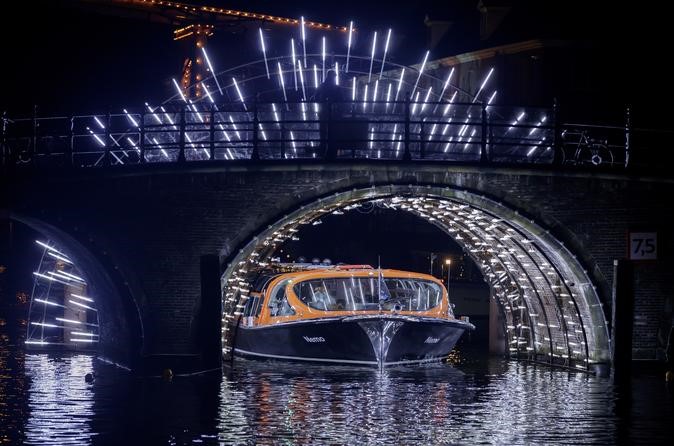
I look at the young couples. I’m trying to figure out how much time, attention and money has been spent on their appearance, such as to allow them to strut confidently on the stage of social media platforms. They may or they may not be aware that their buying behaviour will have been closely stalked and monitored by clever algorithms. Every action, every posting, every online journey is relayed through a Third Party “Server” that is really a Robber. The whole faceless stated raison-d’être of digital attention engineering is to modify and shape human buying and social behaviour. It does this in a ruthlessly effective way. Facebook alone earns at a conservative estimate: $10,000,000 every single day!
The attention engineers use a highly sophisticated understanding of evolutionary psychology. Also they draw upon a deep understanding of behaviour modification methods developed by Skinnerian psychology. They know how to manipulate buying and social behaviour by clever schedules of reinforcement, of reward and punishment. At the same time as they manipulate in this way, they create a convincing front: an appearance of serving your every whim and desire– the Genie in the Lamp! The way that this manipulation has been refined and developed along the way to its application in digital media, is through its cynical application in the highly lucrative gambling industry. It works. If it remains hidden, faceless and non-transparent it will inevitably be as irresistible as the Sirens. Consider how wonderfully simple and devastatingly effective are the techniques that have been brought about by the coming together of behaviour modification techniques and evolutionary psychology. It is all slickly and cunningly achieved by the simple reward of being liked and the punishment of being disliked. Notice how the attention engineers do not need to do the liking or disliking. They simply need to write efficient algorithms that follow and monitor it.
When recently, this cynical manipulation of buying and social behaviour by attention engineers came to light in the Cambridge Analytica scandal, a Channel 4 TV documentary interviewed the then 18-year-old millennials in Central Park New York. The interviewer confronted young people with the skulduggery, theft and deception perpetrated by Facebook. In the main the response of the young people was deeply disturbing but also equally revealing. Many of them said; we simply do not care what Facebook might do to us, we simply cannot survive without it. It would for them, be impossible to stand up first thing in the morning without it, and it would be unthinkable to survive a day without it. What I suggest is revealed here has gone far beyond compulsive behaviour it reveals addiction. Such a tragic level of neediness and addiction is not a sad, “Ooh dear, dear! We-never-saw-that-coming”, an unfortunate side-effect of digital social media. Compulsive addiction is the intended aim. In fact it is the main tool in the toolbox of attention engineers.
Eventually the key issues must come down to the crucial question of individual personal choice. This element of freedom is inherent in the system: it seems so innocuous and helpful when a clever algorithmic cookie suggests: “people who bought this item also enjoyed this”, indeed you don’t have to buy it. However it is known that you are statistically more likely to. This is the subtle level of manipulation within which the algorithm works. When an individual makes key choices and decisions, it seems crucial that the nefarious activities of attention engineering and the multi-billion dollar industry it has spawned, are known and transparent. At least then better informed decisions can perhaps be made!
It is quite possible that the young couples on-board ‘The medium is the Message’ canal tour actually do know a little – or perhaps even a great deal about how they are being manipulated by social media. They may even see themselves as being caringly informed and guided as to how other trendy people are appearing, behaving and what other people are currently consuming. They may even respond in the language of classic addiction:
“It’s okay, I can handle it”.
“I could stop any time”.
“I can use this media to my own advantage”.
It is crucially important to be clear that, just like the youngsters in Central Park New York they are ultimately completely free to make their own personal choice and decisions. Crucially a new transparency needs to be established to better inform such choices and decisions- mired-up as they are in clever manipulations.
The ‘weasely’ misleading terminology around social media needs careful attention. Robbery and theft is what happens when somebody takes something of yours without permission. Someone breaks into my house and steals jewellery, the food from my fridge and money from my wallet. If in court, the perpetrator were to claim that he merely wanted to extract value from my house, wished only to mine my wife’s jewellery box and to harvest the food in my fridge and to scrape the money from out of my wallet, he could and indeed rightly should, be laughed out of court as he is being frog-marched off to jail! Yet it is clear that social media operators entirely without the permission of the millions of individuals whose data was stolen perpetrated the data scraping/extraction, the mining and harvesting of data: taken without their permission. They are a very powerful and wealthy enterprise. They got away with it!
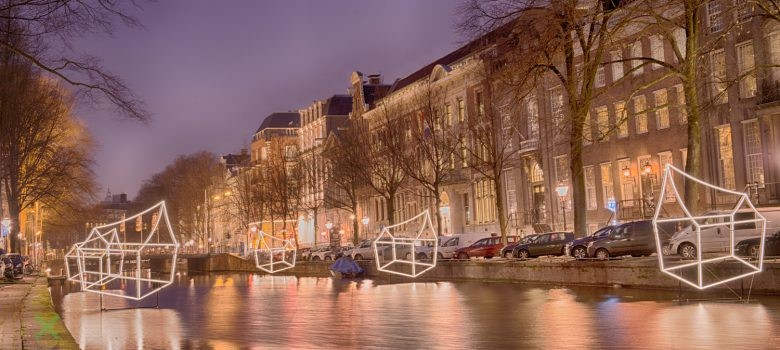
The Sirens in the Ulysses myth are irresistible and so are the attention engineers as long as their lures and manipulations are hidden, non-transparent. It is more than likely that as long as the quality of attention in digital cyberspace can be kept fractured and frenetic, then the terminology of extraction, mining, harvesting and scraping is likely to escape notice for what it is: a linguistic slight of hand: a distraction from an ongoing theft.
The tourist barge glides serenely on through the canals that are lined with opulent houses, palaces and the warehouses built in that highly distinctive 18th century Dutch vernacular architecture. We glide under scintillatingly lit bridges.

Amongst my favourites of the Festival of Light installations are the exquisite floating dandelion seeds. In nature the seeds are broadcast by floating on a spring breeze. Here the reflections of the seeds are picked up in the canal waters reflections.
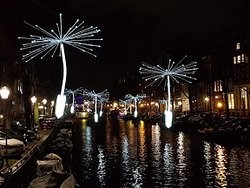
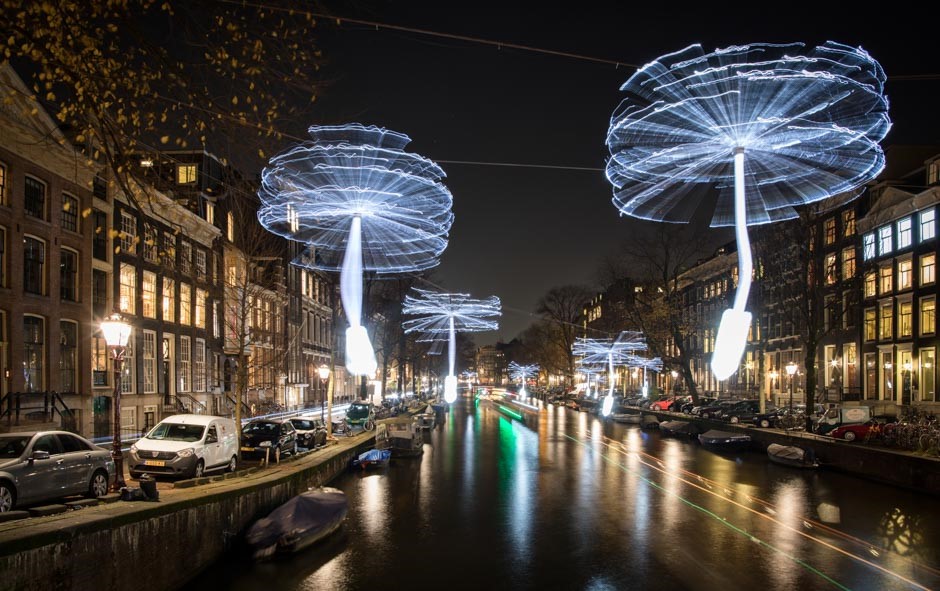
Another impressive installation strung across a bridge captures a medium of information movement as messages move across synapses in the brain.
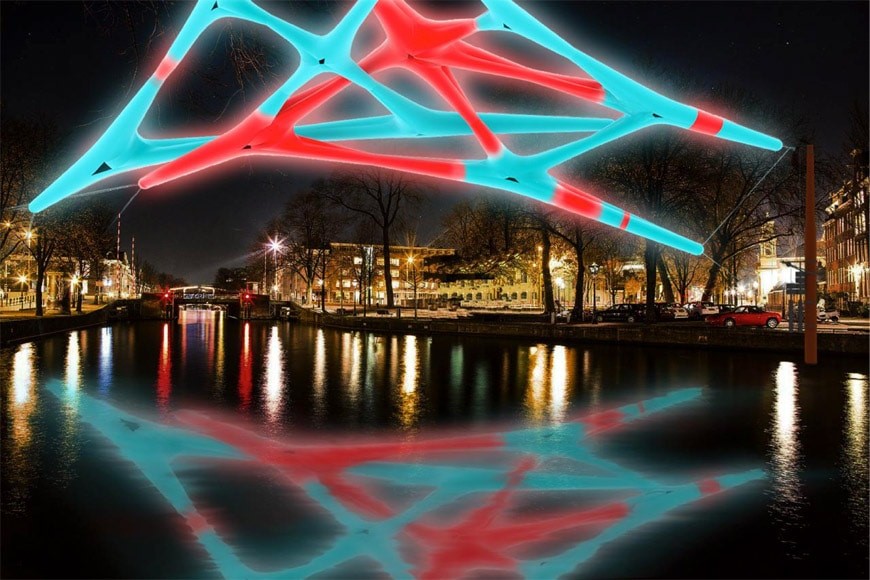
“The medium is the message” tour commentary reminds visitors that while on the journey, to be aware of the hidden messages in the roads, the canal network and in the houses and opulent palaces that line the route. One light installation uses the familiar red and green man pedestrian crossing symbols: the messaging system that regulates the flow of traffic with the need of people to cross a busy city’s roads. Although the red and green men are close to each other they never meet. They are like strangers in the night. The installation allows them for the first time to meet

In much the same way that the British Empire developed, a similarly small country like Holland left its own shores travelling to far distant lands using the latest 16th and 17th century marine and navigation technology. The expressed intention was to discover lands and places from which they could extract wealth. They returned bringing that wealth and opulence back home. The canals and warehouses are a medium that expresses a distinctly colonial message concerning racial superiority and the process of extracting wealth. Amsterdam is the diamond capital of the world. From colonies in South Africa diamonds were mined, as was gold from the Gold Coast of Africa. The coffee, teas and spices of India were harvested by the Dutch East India Company. If you happened to be an indigenous inhabitant of these colonised countries that were “developed” by this colonial model, then you might be forgiven if you came to the conclusion that the resources extracted from your land were considered as a grand theft. The extraction of gold and diamonds from mines, the coal scraped from opencast mining, the harvesting of timber and other exotic foods and spices, the use of captive native populations as slaves, reflect messages of colonial domination based on the extraction of wealth from lands other than your own.
The “ Medium is the Message” cruise is passing by the ghostly three white life-sized figures that sit together on the same bench at the same spot, on the same canal bank in Amsterdam.
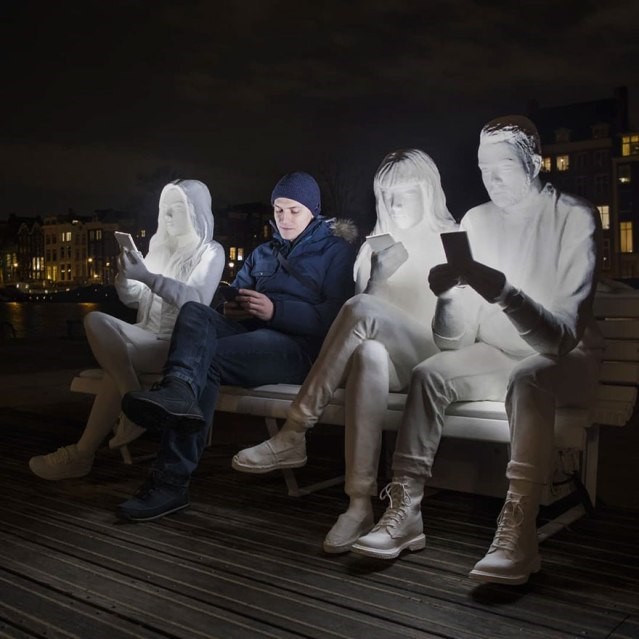
It is a very familiar scene. The bodies of the people – the human beings that they depict, also occupy the same physical space and time. However psychologically they are not present – they are not together in the same space and time. They are not aware of each others’ presence. They are not even be aware of their own presence in that space in time. If they are distant and absent then where have they gone, where are they?
There is a monumental paradox: the digital devices that they each hold in their hands and that has pulled them out of any sense of presence and awareness of what is around them, has been created by a digital world of instant human communication that has eliminated distance and at the same time eradicated human closeness and presence. This digital medium of the Internet carries a hidden, tacit message that human closeness and all that that human presence represents: human warmth, touch-contact, kinship and kindness are largely irrelevant to the way human interactions are conducted. In the same way that extractive capitalism and the technologies that it creates change the way that we think and interact, even the way that our brains are structured, so digital technology will similarly shape and change us.
We are returning to our tour starting-point as we cruise now along the Amstel River leaving behind the Hermitage and Gali May Lucas’s three figures “Absorbed by Light. I have a forehead-smiting moment. How come I missed it all along. That the same terminology is used by digital technology and colonial extractive capitalism is no coincidence! It is because both seventeen and eighteen century colonialism and the current workings of the Internet share exactly the same extractive model. The medium and their associated hidden messages are the same! The extraction of value by promulgating a consumer driven neediness, the scraping, the mining and the data harvesting enables great wealth to flow into global corporations. It is simply the old extractive capitalism in a new guise. The colonialists, like the social media corporations were likewise rich and powerful. They too also got away with it!
I am surrounded by media and by messages of many kinds – besides those whizzing around in the blue-white light of digital cyberspace. I stand under the medium of the tree, humbled by the fact that at best, I can only ever be present for perhaps a tiny percent of all those media and their complex messages that incessantly modify shape and control my behavior, how I relate to myself, to others and to the world around me.
I am humbly grateful to the messaging medium of my genes that form such a vital information network, a medium that carries many messages regarding our species origins. If I can open and connect to this medium then perhaps I can pick up key messages about our shared species evolution. This medium of procreation and re-generation is after all the ultimate distributive media: it is how our seeds of ancestry are broadcast through the generations to arrive at this present-moment and the preciousness of life that it embodies.
If the genes are an inherently selfish medium, then the genealogy that they support is equally and oppositely unselfish and full of a generosity of spirit – not to say the human spirit. It is full of an authentic concern for the future and for the future generations. We care about how our wisdom, our knowledge and our techniques will pass down the generations. It makes us uniquely human.
Just as I may straighten-up right-now after the canal cruise, to look up into the tree at this exquisitely carved little woodworker sculpture and consider the future generations, so my long dead Woodward ancestor, may well also have straightened up from the branch that he was sawing. He is the ancestral Wood-Warden, the Carer of the Forest. He takes a deep breath and smells the intimate, warm, musky fragrances of the forest. He thinks about the future.
He leaves this message in my genealogical inbox:
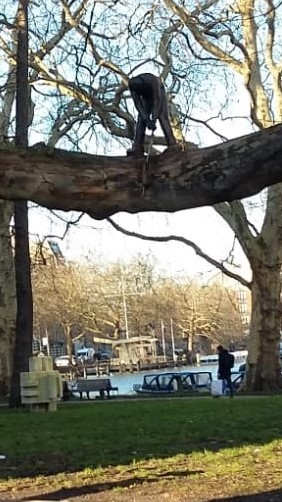
The precious life that you have now takes you on a journey as you inch by inch move along a branch. Every moment that you live you will remain connected to the Tree of Life. Every moment that you live you will move inevitably closer to the end of the branch that is your life. At your last breath you will fall from the branch to the forest floor in order to decompose and become yet another media, the fungi, the soil that will continue to be part of, and support the tree of life. Then your body will be transformed into another medium, another channel for information to flow through.
Truly value and cherish this life, in this moment and you will be empowered by the connection that you have to the Tree of Life of which you are, but an alive, growing and developing branch. This sense of connection will inevitably fill your whole being with the presence of a Love that is shared with all the other seeds, twigs, leaves, branches roots that form the tree. If you cut yourself off and disconnect from all that you are such an integral part, and that supports your every moment of life, then you are likely to saw yourself off the branch that supports you.
Be present and aware of the rich and intimate interconnections as you look up into the branches of this tree. Tune-in and perceive this message and you will never become detached and isolated from that extraordinary love that will support your every action.
We are the Song of the Ancestral Carers and Wardens of the Woods and Forests of your origins. We remind you that trees are the Planet’s distributive medium that forms the lungs of the world that deliver the breath in your chest. We remind you that your every breath until the last one, as you inch along toward the end of the branch when you naturally fall to become compost, is a medium that carries this message. Whenever you stop listening closely to the Song, if you fail to join us and to sing the Song, then in your distraction you may well saw yourself off the branch that supports you!
Exactly what kind of message was that?
Did I really receive a shamanic message from long dead ancestors tens of thousands of years ago?
It has none of the clear, cool lines and precise rigour of scientific thinking, more like the sinewy and gristly messiness of poetry.
NO I did not receive a shamanic message from ancestors!
I made those paragraphs up. I created the words and sentences with the clear thought in mind that I definitely have ancestors who passed their genes onto me. I let my mind then play freely with the likelihood that, in all probability, there were times when those ancestors both thought and cared about me who was then, way back in the past, a projection, something that would manifest itself many thousands of generations in the future. As well as dealing with death and falling off the branch, our ancestors must certainly have held a new born baby for the first time and wondered in awe: that is the most likely future-casting moment!
A deeply skeptical part of me is disturbed by the weird elision of past and future that happens in the world of instant digital media communication and gratification. It destroys the present-moment as well as limiting any sense of the future. We have become so impatient that we cannot wait the moments that it takes for the kind of real timelines to unfold, ones that involve the embodied, physical reality: of really following somebody, for real visits and for actual journeys. We are being subtly robbed of that kind of time because the future is NOW and because later on, i.e. The Future, becomes ever more frighteningly overloaded, backed up with a backlog of captured recorded moments.
How is it at all possible to keep up with this?
If every moment of life is carefully captured and recorded then it requires another entire lifetime to catch up! But I do not have another lifetime – just this one! There is only a certain amount of time before the inevitable fall from the branch. Maybe becoming absent neurotically caught-out and pulled-out of the present-moment is another way that I saw myself off the branch. To fall is the ultimate disconnection!

Marshall McLuhan, 52 years ago published “The Medium is the Massage”. It gave the name to this year’s 2019 Amsterdam Light Festival – only well – that is not quite true! Look back at the start of the paragraph and at the title of Wiener’s book. It says “Massage” where you thought it should be “Message”. It is not my typo. Originally it was a typesetting error made in the dark days before computer-driven text spellcheckers but it was a mistake that delighted Marshall McLuhan – so much so that he insisted that it remained to this day the title of his seminal work.
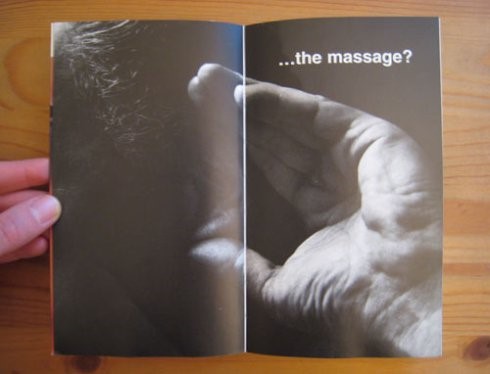
Marshall McLuhan loved the way that letters and words work as the medium of certain messages. He played with four permutations here. The original typesetter’s mistake: ”Massage” carries over a sense of sensual physicality, the communication by touch, a hand-to-flesh stroke or manipulation. This reminds us of the origin of the word “contact” which we very often use instead of “communication”. How often we say:” I will be in touch soon”. The roots of the word “contact” mean: “with” ”touch”. However, we also use: “Massage” in yet another deceptive sense: a more tricksy meaning: in accountancy terms, a way of disguising the figures to make them appear a bit better than they in fact are. Another mistaken touch of the space-bar in the middle of the word gives us “Mass Age”: the age of instant mass contactless communication. The originally intended word: ”Message” can also be cut-up in the same way and this gives us: “Mess Age”. The “Mess Age” could then become: the age when we lose real human contact and values in a Cyber world that has become a mess of instant mass-communication. Bah BOOOM! The man’s a genius.
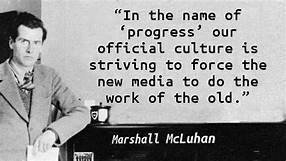
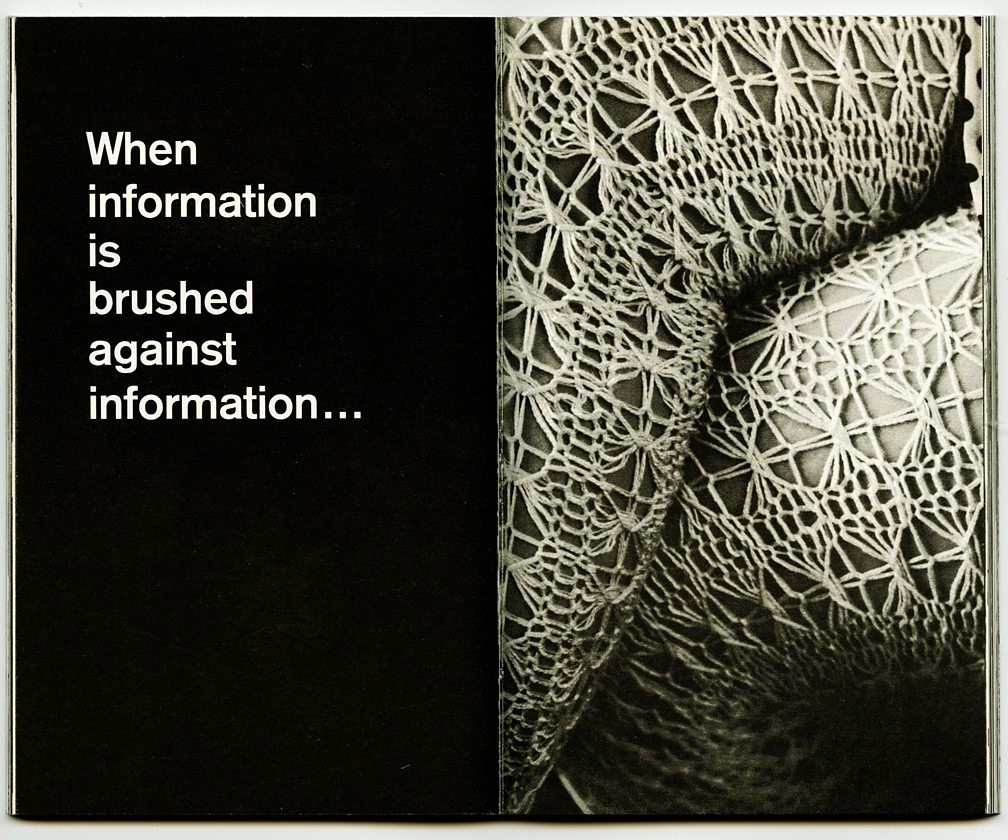
In 1967 when Marshall McLuhan’s book was first published, I was 20 years old and in my first year of study on an undergraduate course in experimental psychology…by the way…
… I’m still standing under my Woodward’s tree- only this time instead of consulting with my tree-loving ancestors I am connecting with my own earlier life. Now at the age of 71, the 20-year-old-me feels like another incarnation! I want to discover why I am so disconcerted and bothered by my experience of the “Medium is the Message” Amsterdam Light Festival…
… Back in the late 1960s I was passionately committed to the science of experimental psychology. I was passionate, perhaps in the way that only youth can be! I believed in the ideals of an objective value-free scientific psychology. It was an ideal. I am sure there never was an ivory tower of intellectual endeavor entirely value-free and untainted and unbiased by commercial or other vested interests. Back then, in the days before corporate involvement in universities, it was easier to believe in such an ideal! I was idealistic. I believed fervently that what could be discovered in psychology could enable the next generation to be more vigilant and aware of threats to human freedom and democracy. A better understanding of our social behavior and our psyche would make for a population of more responsible citizens with the capacity to see through the manipulation, domination and control of various forms of tyranny.
We held an uncertain future in our hands. Nuclear extinction was an ever-present threat. The near disastrous Bay of Pigs episode had occurred in 1961 – only a handful of years earlier. Despite the very real threats from the Cold War and nuclear annihilation, we held a hopeful and optimistic future in our hands.
There were so many formative developments at that time that have shaped the future that is NOW – the present day: Using the recently devised computer program languages, Algol and Fortran, we learned to program the fancy calculators that had only recently been named computers. We studied Information Theory and in particular the work of Norbert Wiener who coined the term “Cybernetics” and therefore, probably was the founding father who christened what was to become Cyberspace.
Far away the “hottest” psychology of the day was behavior modification that had been developed by behaviourist psychologist B.F Skinner. If it moved we measured it! We run rats through endless mazes, learning how to schedule reward and punishment in order to modify and shape a lab rat’s behavior.
For sure, my young eyes would have read the paragraph in Norbert Wiener’s book “The Human the use of Human Beings” in which he undertook a truly extraordinarily prescient bit of crystal-ball gazing. Wiener describes a future dystopia in which a globally linked computer-driven information-processing system gains complete behavior-modification control over the population. This is the stuff of Sci-Fi in which a tyrannical elite is constantly able to modify and shape behavior using Skinnerian operant-conditioning methods. In order to achieve this there has to be a supporting information network in which almost every member of the population has a device that links them to the network connected to their person. The reward and punishment would have to be administered instantly in order to modify behavior effectively. Norbert Wiener roundly affirmed with the weight of his authority and his world leading expertise and knowledge of information processing technology that this nightmare scenario could never happen. Technologically it was not feasible and never would be. In his future casting he was right about the Dystopia and wrong to cast a future in which it could never happen. That future is now!
“Beyond Freedom and Dignity” was the title of BF F Skinner’s seminal work published in 1971. During the late 60’s I was deeply, passionately concerned about the potential future that might lay ahead- beyond human freedom and dignity. We argued late into the night considering the ideas of Noam Chomsky who also had great misgivings about behaviourism and the way that the future was then shaping up.
The fact is that Norbert Wiener’s “nightmare scenario” is our present-day reality. The future is now. The attention engineers operate in an arena that is beyond human freedom and dignity. At least I am now clear in my mind precisely what it was that intuitively so bothered me about the behaviorist psychology that I was taught in the late 1960s. I was passionate and expressed deep concern about a model of human behavior that sees human beings as machines, a Black Box that contains nothing but linear chains of stimuli and responses that are conditioned and shaped by schedules of reward and punishment. It is obviously true that our behavior is shaped by reward and punishments: by attraction and repulsion and by pleasure and by pain. A model like this does not allow for, or acknowledge the possibility that human freedom and dignity can rise above conditioned and habitual patterning. It is what makes us human: our supreme inheritance.
Crucially we now need a radical turn-around, we must somehow flip a situation in which we have come to think that human beings are the problem to which digital technology is supplying the solution. The media, particularly social media has successfully transmitted this message. It is important to bear in mind that digital technology is not the problem: it is the way that it is used to transmit such a hidden message. We can flip this around so that human beings become the solution to the deep and profound problems currently caused by Digital media: the unique malaises, the human unhappiness and discontent that are caused by the hidden transmission of certain tacit messages. If such a turn-around comes about then, we could use all the magic, algorithmic chicanery to guard and protect us from any dark and deeply cynical, manipulative intent, one that truly is beyond human dignity.
I think that we need to be as idealistic as possible in this arena. We need to take back the future and shape it with human understanding, freedom and dignity. If this flip-around is at all possible and not an idealistic dream, then the top priority will become: to deal with the hidden shaping message that forces human beings to behave like machines when they operate and interact in cyberspace. If we are shaped in this way, then we inevitably move beyond freedom dignity. We have come to see ourselves in the image of the machines that we create. The operating space beyond freedom and dignity demands that we behave more and more like machines – more like Skinner’s Black Boxes. Then, we finish up serving the machines – rather than the machines servicing and protecting our freedom and dignity.
Right down at the very foundation of all this digital cyber-technology is a binary logic: a simple all or nothing choice: an option that is forced-patterned such that is it is either ‘0’ or ‘1’. What makes us human lives in the space between ‘0’and ‘1’. What makes us human is that we can want, we can desire, dream of a situation in which we can have a smidgen of 1 and the first part of 0! To dream this way is not undignified!
The shaping to make us behave in a Black Box fashion is now so much a part of our daily lifestyles. Continually we are bombarded by messages to listen carefully to the following options, to place a tick in one of the following boxes. You are force-patterned to choose those linear options. Your are offered the “following options” and indeed, there are no choices in the spaces in between these options. The system will neither know nor tolerate such ambiguity. The Internet and the operations of cyberspace are an amazing human invention. In the blink of an eye it can easily carry out a million operations that are way beyond any human capacity. We should not in any way be belittled by this but proud and dignified about the achievement. We should also use such a medium to continuously remind ourselves that: amazing as the tool is that we have so creatively invented, it cannot not even for one micro-second operate if there is any ambiguity in the space between ”0” and ”1”. If it is not ‘0’ then it must be “1’. There is no alternative. In the medium itself there is a built-in intolerance. Cyberspace must eradicate and eliminate every last vestige of ambiguity. If you behave like a machine in cyberspace then one important consequence is that interpersonal interaction tends to become like a computer game of domination and control. In such circumstances we should not be surprised when cyberspace fills with trolls, ‘bots and fake people who promulgate hatred, intolerance and who conduct their affairs with a dominating and malicious vehemence. Any resonance with Fascist Europe?
On that Amsterdam evening cruise we cruised by Anne Frank House and the museum that archives a truly horrific story. In a very real sense the ultimate indignity, as it was for the Jews who were branded with a depersonalized number in German occupied Amsterdam, is to be treated as a subhuman number: an inferior race. Today the Nazis would have no need to go to the considerable time and expense of tattooing people: all that is required is a quick DNA sample that is numbered and instantly stored in an icloud. Combine this with a GPS tag so that The Reich always know precisely where everybody is at any given moment and Bang!! You have the Fascist dictatorship’s dream scenario!
In my humble opinion in the twentieth century, the best piece of psychological research by far, was one that was undertaken by Theodore Rosenthal in the few years before my psychology degree. This research into the psychological roots of fascism showed in a peer reviewed, solidly scientific way: that running through the centre of a Fascistic personality, as through a stick of Blackpool Rock, is an intolerance of ambiguity!
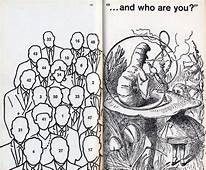
Algorithms are extraordinary impersonal number–crunching systems. Their predictive wealth-extracting power grows in direct proportion to the number of persons in the “engaged” (“on-line”) population. It needs enormous data-crunching power to achieve this but the bigger the cohort the more accurate the prediction, the more clicks, the more the advertising revenue. There is no freedom. Abandon Hope. There is no escape: Behaviour Modification, Numbers and Indignity Rule!
The Internet and cyberspace does not have to operate beyond human freedom indignity. The operation of the digital medium of the Internet is such as to make it potentially a wonderful medium for the distribution of messages of human values and dignity. It is a far more a natural medium suited for sharing and spreading than one for extracting and accumulating. To achieve this is surely not an idealistic dream. It is not undignified to demand the spaces-in-between those options! To realize its great and truly human potential it is vitally necessary for Cyberspace to guard and protect itself against anything that operates beyond human freedom and not to promote and promulgate all that facilitates it. It has to be re-visioned and rebuilt so that it gravitates toward human kindness. Allowing this not to happen is the Internet’s fatal flaw. It is ultimately a human flaw! We could so easily repair that flaw and then, the elements that make us truly human, the ones transmitted through closeness and the living warmth of human contact, kindness and kinnedness, may reconnect this astonishing medium back to the messaging media of our human origins. As it currently operates it tends to disembody and become radically disconnected from these origins. We need to wake up and remember that human dignity and freedom operate in the spaces in between – where a tolerance of ambiguity and diversity live and breathe.

In the 1970’s I dropped out of Academic psychology after seven years of post-graduate research. At that time there were more spaces in between. It was quite possible to live in the interstices. While there were back then the rows and columns that reduce human beings to numbers, there remained the spaces-in-between that facilitated a healthy dissent and creativity. There was an Alternative Scene with a language that talked about option like not buying into a life and career in which you were co-opted by corporate capitalism. I became more and more disenchanted as corporate interests infiltrated their wealth-extractive principles into academia.
There is an intriguing possibility that I somehow picked up a subliminal message from that typesetters error in Marshall McLuhan’s book title. What I dropped into was a life and career spent cultivating and refining the medium of human communication that is touch! Real contact. “The medium is the massage” became my great adventure in the spaces-in-between.
I have often entertained a regret that at that time I was far too idealistic. Recently I have spoken with a great friend and mentor who I first got to know in the 1960s and who studied psychology with me on that degree course. He pointed out and I wholeheartedly agreed: that we were not idealistic enough. The optimistic future that we held in our youthful hands could have been better stewarded and protected by linking up with others with an even greater and more idealistic zeal. It is not too late!
As I looked from the little Woodward icon up in the tree and down to my bare feet I realised that for most of my drop-out lifestyle I have been out on a limb. I walk away from the tree with my knuckle pressed on my lip having picked up a powerful message that has given me a strong and firm resolve. There might not be too much left of the branch for me to inch along but I will straighten-up my back and stop sawing myself off the limb that I am out on.
